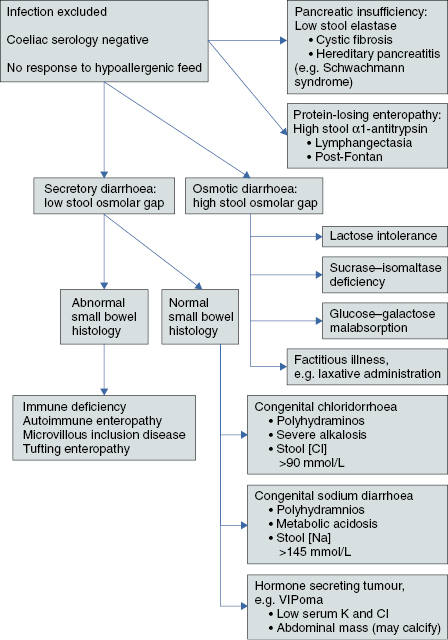Information: Defining the type of diarrhoea helps direct the assessment of cases
- Osmotic diarrhoea:
- Stops on fasting within 24 hours
- Stool pH usually <5 (acid from fermented malabsorbed sugars)
- Low stool sodium (<70 mmol/l)
- High measured osmolality (often >400)
- Stops on fasting within 24 hours
- Secretorydiarrhoea:
- Continues despite fasting
- Fasting stool pH usually >6
- High stool sodium (>70 mmol/L)
- High measured osmolality (often 280–320 mOsmol/L)
- Fasting stool pH usually >6
- Osmolar gap: measured osmolality minus calculated osmolality ([Na] + [K]) × 2
- Protein-losing enteropathy: steatorrhoea, hypoalbuminaemia, raised stool alpha-1-antitrypsin levels, lymphopoenia and hypogammaglobulinaemia
Differential diagnosis (see Algorithm 9.1)
- Common:
- Non-specific (functional diarrhoea), e.g. toddler diarrhoea
- Post-infectious (transient) lactase deficiency
- Cow’s milk/soya protein intolerance
- Coeliac disease (see Chapter 12)
- Cystic fibrosis
- Short bowel syndrome
- Motility disorder, e.g. after gastroschisis repair
- Infectious, e.g. Cryptosporidium, Giardia, Entamoeba
- After chemotherapy or radiotherapy
- Graft-versus-host disease
- Drug side-effects
- Non-specific (functional diarrhoea), e.g. toddler diarrhoea
- Rare:
- Primary or acquired immune deficiency: recurrent infection, skin rashes
- Sucrase–isomaltase deficiency: watery diarrhoea onset at weaning
- Infant-onset inflammatory bowel disease, e.g. interleukin (IL)-10 receptor deficiency
- Secretory tumours, e.g. VIPoma: abdominal mass, abnormal gut hormone profile
- Lymphangectasia: raised stool alpha-1-antitrypsin
- Pancreatic insufficiency, e.g. Schwachmann syndrome (neutropoenia and skeletal abnormalities)
- Autoimmune enteropathy: antienterocyte antibody
- Abetalipoproteinaemia: acanthocytes on blood film
- Chlylomicron retention disease (Anderson’s disease): typical small bowel histology
- Zinc deficiency: perianal and perioral skin rash
- Eosinophilic gastroenteritis: typical small bowel histology
- Intractable diarrhoea syndromes:
- Congenital chloride diarrhoea
- Congenital sodium diarrhoea
- Glucose–galactose malabsorption
- Microvillous inclusion disease
- Tufting enteropathy
- Trichohepatoenteric syndrome (phenotypic diarrhoea of infancy)
- Congenital chloride diarrhoea
- Primary or acquired immune deficiency: recurrent infection, skin rashes
Algorithm 9.1 Biochemical assessment of chronic diarrhoea in infants





